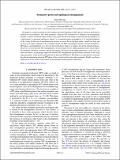Symmetry-protected topological entanglement
Author(s)
Marvian, Iman; Marvian Mashhad, Iman
DownloadPhysRevB.95.045111.pdf (1.005Mb)
PUBLISHER_POLICY
Publisher Policy
Article is made available in accordance with the publisher's policy and may be subject to US copyright law. Please refer to the publisher's site for terms of use.
Terms of use
Metadata
Show full item recordAbstract
We propose an order parameter for the symmetry-protected topological (SPT) phases which are protected by Abelian on-site symmetries. This order parameter, called the SPT entanglement, is defined as the entanglement between A and B, two distant regions of the system, given that the total charge (associated with the symmetry) in a third region C is measured and known, where C is a connected region surrounded by A, B, and the boundaries of the system. In the case of one-dimensional systems we prove that in the limit where A and B are large and far from each other compared to the correlation length, the SPT entanglement remains constant throughout a SPT phase, and furthermore, it is zero for the trivial phase while it is nonzero for all the nontrivial phases. Moreover, we show that the SPT entanglement is invariant under the low-depth quantum circuits which respect the symmetry, and hence it remains constant throughout a SPT phase in the higher dimensions as well. Also, we show that there is an intriguing connection between SPT entanglement and the Fourier transform of the string order parameters, which are the traditional tool for detecting SPT phases. This leads to an algorithm for extracting the relevant information about the SPT phase of the system from the string order parameters. Finally, we discuss implications of our results in the context of measurement-based quantum computation.
Date issued
2017-01Department
Massachusetts Institute of Technology. Research Laboratory of ElectronicsJournal
Physical Review B
Publisher
American Physical Society
Citation
Marvian, Iman. “Symmetry-Protected Topological Entanglement.” Physical Review B 95.4 (2017): n. pag. © 2017 American Physical Society
Version: Final published version
ISSN
1098-0121
1550-235X